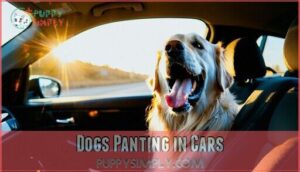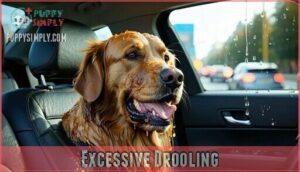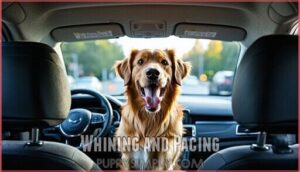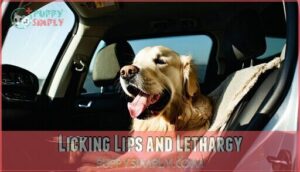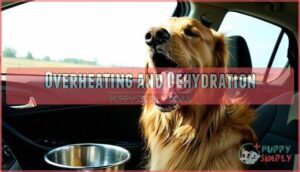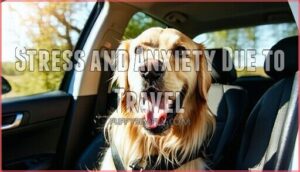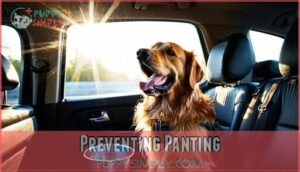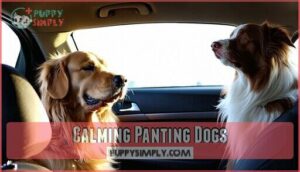This site is supported by our readers. We may earn a commission, at no cost to you, if you purchase through links.
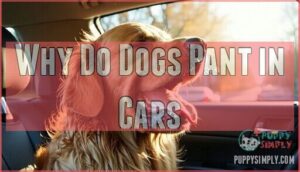 Dogs pant in cars to cool down, manage stress, or deal with motion sickness.
Dogs pant in cars to cool down, manage stress, or deal with motion sickness.
Panting is their natural way of regulating body temperature, especially in warm environments.
It can also signal anxiety from unfamiliar surroundings or the movement of the car.
Sometimes, dehydration or excitement plays a role—imagine your dog anticipating a fun trip!
However, excessive panting might mean discomfort or overheating, which can be risky.
Keep the car cool, offer water, and make rides more relaxing by acclimating your dog to travel.
Understanding why dogs pant in cars helps you guarantee their safety and comfort during every journey.
Table Of Contents
- Key Takeaways
- Dogs Panting in Cars
- Why Do Dogs Pant in Cars
- Signs of Panting
- Causes of Panting
- Preventing Panting
- Calming Panting Dogs
- Frequently Asked Questions (FAQs)
- How do I stop my dog from panting in the car?
- Why does my dog breathe so loud in the car?
- How can I tell if my dog is panting too much?
- Are there any health risks associated with panting in the car?
- What can I do to prevent my dog from panting in the car?
- Are there any signs that my dog is feeling anxious in the car?
- Is there anything I can do to make the car ride more enjoyable for my dog?
- Can certain breeds pant more than others?
- Does diet affect a dog’s panting behavior?
- How does age influence panting during car rides?
- Conclusion
Key Takeaways
- Keep your dog cool with air conditioning, water breaks, and proper ventilation to prevent overheating and dehydration.
- Gradually acclimate your dog to car rides with short trips and positive reinforcement to ease anxiety and stress.
- Watch for signs of discomfort like excessive panting, drooling, or pacing, and address them immediately to ensure safety.
- Consult a vet if panting persists or seems abnormal, as it could indicate motion sickness or underlying health issues.
Dogs Panting in Cars
Dogs pant in cars for several reasons, including heat, stress, and motion sickness. Understanding these causes helps you make certain your dog stays comfortable and safe during car rides.
Panting in cars signals discomfort—address heat, stress, or motion sickness to keep your dog safe and relaxed during rides.
High Body Temperature
When car temperatures rise, dogs struggle with heat regulation due to their limited sweat glands.
Brachycephalic breeds face higher risks, making thermoregulation even harder. Watch for heatstroke symptoms like excessive panting or lethargy.
Keep your dog cool with these methods:
- Turn on the air conditioning for proper airflow.
- Provide a cooling mat for comfort.
- Offer frequent water breaks.
- Avoid parking in direct sunlight.
Motion Sickness
Motion sickness often causes dog panting during a car ride.
It stems from inner ear imbalances, leading to nausea, drooling, and anxiety.
Younger dogs are especially prone to this.
Acclimation training, like short trips with rewards, helps ease discomfort.
If symptoms persist, medication options for car sickness can provide nausea relief.
Always consult your vet for safe solutions.
Dehydration
Dehydration during a car ride can sneak up on your dog, especially in warm weather.
Panting causes water loss, and without proper water intake, it disrupts electrolyte balance and kidney function.
To prevent dog overheating and heatstroke risk:
- Offer water regularly.
- Take frequent breaks.
- Use cooling mats.
- Recognize dehydration signs like dry gums or lethargy.
Anxiety and Stress
Travel anxiety can make your dog pant excessively during car rides, especially if fear triggers like unfamiliar environments or past vet visits are involved.
Recognizing stress signs early is key to calming techniques. Positive association training, soothing sprays, or medication options can help. A calming home environment can also substantially reduce anxiety before and during travel.
Always aim to create a safe, stress-free space for your furry friend.
| Stress Sign | Possible Cause | Solution | Outcome |
|---|---|---|---|
| Whining | Fear of car rides | Positive association training | Reduced anxiety |
| Pacing | Travel anxiety | Calming sprays or soothing music | Relaxed behavior |
| Excessive drooling | Stress or nausea | Frequent breaks, medication | Improved comfort |
| Licking lips | Nervousness | Gradual acclimation to car rides | Increased confidence |
Why Do Dogs Pant in Cars
Dogs pant in cars for various reasons, often tied to their unique physiology and emotional state.
Panting in cars reveals how dogs manage heat, stress, and excitement, highlighting their unique needs during travel.
They can’t sweat like humans, so panting helps cool them down, especially when air quality or car position limits ventilation.
Dog anxiety during car travel, often linked to past experiences, can also trigger panting.
Breed predisposition plays a role too, with brachycephalic breeds struggling more.
Car sickness is another culprit, causing discomfort and drooling.
Acclimation benefits include reducing stress and making car rides more enjoyable.
- Heat regulation challenges
- Anxiety from unfamiliarity
- Poor ventilation or air quality
- Breed-specific breathing issues
- Car sickness symptoms
Signs of Panting
You’ll notice signs of panting when your dog starts breathing heavily, often with their tongue hanging out.
Other clues like excessive drooling, whining, or pacing can signal discomfort that needs your attention.
Excessive Drooling
Excessive drooling during a car ride often signals dog anxiety, motion sickness, or overheating.
Some breeds are more prone to drooling, especially in stressful situations. Keep an eye on drooling severity, as it might require oral examination or treatment.
Offer water, make certain ventilation is adequate, and monitor closely for signs of distress.
| Cause | Severity | Action |
|---|---|---|
| Anxiety | Moderate | Use calming sprays |
| Motion Sickness | High | Consult a veterinarian |
| Overheating | Severe | Cool the car |
| Breed Predisposition | Low to Moderate | Provide comfort |
| Oral Issues | High | Seek veterinary care |
Whining and Pacing
Whining and pacing during a car ride can signal dog anxiety or discomfort.
Restlessness signs like compulsive pacing often stem from anxiety triggers or vocalization causes.
Look for:
- Uneasy movement or circling in the car.
- Persistent whining tied to dog panting.
- Behavioral solutions like calming sprays.
- Attempts to escape confined spaces.
- Reactions to unfamiliar noises or vibrations.
Licking Lips and Lethargy
Spotting lethargy symptoms during a car ride, like licking lips or seeming tired, can signal dehydration signs, nausea indicators, or even underlying illnesses.
These subtle dog behaviors might mean your pup isn’t feeling great. Don’t ignore these cues—schedule a veterinary examination if needed.
Keeping water handy and ensuring comfort helps prevent dog panting and promotes a smoother trip for everyone, which can be crucial in preventing dehydration signs and reducing nausea indicators.
Panting Uncontrollably
Uncontrollable dog panting during a car ride could signal breathing difficulty, anxiety, or even motion sickness.
Watch for unusual symptoms like fainting spells, pale gum color, or exercise intolerance, as these may indicate heatstroke or health issues.
If the panting persists, pull over, offer water, and check for overheating. Persistent distress warrants a vet visit to rule out serious conditions.
Rapid panting at night can also be a sign of distress; monitor your dog for signs of abnormal panting.
Causes of Panting
Dogs pant in cars for several reasons, including overheating, dehydration, and stress.
Excitement or motion sickness can also trigger panting, making it important to understand what’s causing your dog’s discomfort.
Overheating and Dehydration
Panting can signal overheating or dehydration, especially in hot cars.
Dogs struggle to cool down due to their limited sweat glands, relying on panting instead.
High temperatures and poor ventilation increase heatstroke risks, with symptoms like heavy breathing and lethargy.
Make certain water availability and use cooling products to keep your pup comfortable, as some breeds, like brachycephalic dogs, are more sensitive to heat, so maintaining proper airflow is critical for their safety.
Stress and Anxiety Due to Travel
Why does travel anxiety turn car rides into stress-filled adventures for dogs? It’s often due to unfamiliar environments, sensory overload, or past negative experiences.
You’ll notice signs like panting, pacing, or drooling.
Combat this with:
- Positive association: Pair car rides with treats or fun destinations.
- Calming techniques: Use soothing music or pheromone sprays.
- Gradual desensitization: Start with short, low-stress trips.
- Medication options: Consult your vet for severe anxiety.
Dog Car Excitement
Excitement during a car ride often stems from Puppy Anticipation and Destination Association.
Dogs connect car trips with fun places, like parks, boosting their energy levels.
Breed Temperament also plays a role, as high-energy breeds pant more.
Positive Reinforcement strengthens this link.
| Trigger | Effect |
|---|---|
| Anticipation | Increased heart rate, panting |
| Positive Associations | Builds excitement for destinations |
| Breed Temperament | High-energy breeds pant more |
| Car Environment | Stimulates senses, amplifies excitement |
Preventing Panting
You can help prevent your dog from panting in the car by keeping the environment cool, offering water regularly, and easing them into car rides gradually.
These steps make the trip more comfortable and also reduce stress and potential health risks.
Keeping The Car Cool
High temperatures in a car can quickly lead to overheating for your dog.
Use air conditioning or open windows slightly for proper ventilation strategies. Cooling products like mats or vests can also help.
Park in shaded areas or use shade solutions like window covers. Regular temperature monitoring keeps the car stays comfortable.
These cooling methods keep your pup safe and prevent panting caused by heat stress during rides. Recognizing excessive panting signs is vital to take immediate action and guarantee your dog’s safety.
Providing Water Breaks
Keeping your dog hydrated during car rides is essential for their comfort and health.
Always carry fresh water and a collapsible bowl. Follow these tips for hydration:
- Offer water breaks every 30-60 minutes, especially on hot days.
- Use cool, not ice-cold, water to prevent stomach upset.
- Consider electrolyte solutions for extra hydration.
- Choose spill-proof bowls to avoid messes in the car.
Consider a portable water container for added convenience. Stay proactive to prevent dehydration!
Gradual Acclimation to Car Rides
After ensuring water breaks, focus on easing travel anxiety through desensitization.
Start with short trips, letting your dog explore the car while it’s parked.
Reward calmness with treats and praise to build positive associations.
Gradually increase time inside, ensuring comfortable seating and a relaxed atmosphere.
Avoid vet visits initially to reduce stress.
With patience, even anxious pups can learn to enjoy a car ride without fear.
Calming Panting Dogs
Helping your dog stay calm during car rides can make the experience safer and more enjoyable for both of you.
By addressing their discomfort with simple strategies like training, cooling measures, and professional advice, you can ease their panting and stress.
Training and Acclimation
Start with short trips to help your dog feel at ease during a car ride. Use positive association training by pairing the experience with treats, praise, or toys.
Desensitization methods, like letting them explore the car while parked, build confidence. Reward calmness consistently to reinforce good behavior.
One helpful technique is to focus on rewarding calm moments to reinforce the desired behavior. Make certain secure seating for safety and comfort.
Gradually increase trip length, making each outing a step toward reducing anxiety and improving dog comfort.
Managing Heat and Anxiety
To manage heat and anxiety during car rides, focus on cooling techniques like air conditioning or using cooling mats.
Offer water frequently—hydration methods are key to preventing overheating. Consider using a dog cooling mat for added comfort.
Calming products, such as sprays or chews, can help ease your dog’s nerves. Combine these with acclimation strategies, like short, positive trips.
Pay attention to signs of dog panting or stress, adjusting the environment to keep your pup comfortable and relaxed, utilizing calming products for optimal results.
Consulting a Veterinarian for Advice
If managing heat and anxiety doesn’t ease your dog’s panting, it’s time for vet advice.
A veterinarian can identify underlying conditions like heart disease or respiratory issues, assess breathing patterns, and recommend medication options or behavioral therapy.
Persistent panting may signal medical issues needing veterinary care.
Addressing potential breathing difficulties early can improve outcomes.
Don’t hesitate to seek second opinions if symptoms persist—your dog’s health relies on timely, professional veterinary care to guarantee their comfort and safety.
Frequently Asked Questions (FAQs)
How do I stop my dog from panting in the car?
Keep your dog cool with air conditioning or open windows, offer water regularly, and use calming aids like Adaptil spray.
Gradually acclimate them to car rides with short trips and positive reinforcement for calm behavior.
Why does my dog breathe so loud in the car?
Your dog breathes loudly in the car due to anxiety, excitement, or overheating.
Limited ventilation, motion sickness, or underlying health issues like respiratory problems can also contribute.
Monitor their behavior and guarantee a comfortable, cool environment to address potential overheating.
How can I tell if my dog is panting too much?
Watch for signs like heavy, uncontrollable panting, blue gums, or wheezing.
If your dog seems restless, drools excessively, or shows unusual behavior, it’s time to pull over, hydrate them, and consult a vet.
These signs indicate that your dog may be in distress and needs immediate attention.
Are there any health risks associated with panting in the car?
You face huge risks if your dog’s panting leads to dehydration, heatstroke, or worsens underlying health issues, so monitor their behavior closely.
What can I do to prevent my dog from panting in the car?
You can prevent panting by turning on the air conditioning, providing water, and using a crate to reduce motion sickness and anxiety during car rides.
Are there any signs that my dog is feeling anxious in the car?
Like a nervous passenger, you’ll notice your dog panting, whining, or pacing, indicating anxiety in the car, so stay alert to these signs to guarantee their comfort and safety.
Is there anything I can do to make the car ride more enjoyable for my dog?
You can make car rides enjoyable for your dog by providing a comfortable space, using calming products, and gradual desensitization to reduce anxiety and stress.
Can certain breeds pant more than others?
Some breeds, like Bulldogs or Pugs, pant more due to their shorter snouts, which make breathing harder.
Larger breeds might pant heavily too, especially in warm conditions.
Breed traits can definitely influence panting frequency.
Does diet affect a dog’s panting behavior?
What your dog eats can impact panting.
High-sodium diets or dehydration from poor hydration can make panting worse.
Nutrient-rich, balanced meals and consistent water access help maintain their energy and regulate body temperature effectively, which are key to helping your dog, with balanced meals being particularly important.
How does age influence panting during car rides?
Age plays a big role in car ride panting.
Puppies often pant from excitement or motion sickness, while older dogs may struggle with anxiety, pain, or health issues like heart problems or respiratory challenges during travel.
Conclusion
Keeping your dog safe and comfortable during car rides doesn’t have to be a wild goose chase.
Dogs pant in cars for many reasons—heat, stress, or even excitement—but understanding these causes helps you address their needs.
Keep the car cool, offer water, and ease their anxiety with gradual travel training.
If panting becomes excessive, consult a vet to rule out health issues.
With a little effort, you can make every trip enjoyable for your furry friend.
- https://vcahospitals.com/know-your-pet/motion-sickness-in-dogs
- https://www.akc.org/expert-advice/health/warning-signs-dehydration-dogs/
- https://www.merckvetmanual.com/dog-owners/bone,-joint,-and-muscle-disorders-of-dogs/overview-of-musculoskeletal-disorders-and-diseases-in-dogs
- https://vetmed.tamu.edu/news/pet-talk/the-dangers-of-leaving-fido-in-a-hot-car/
- https://t.sidekickopen14.com/s3t/c/5/f18dQhb0V1-gmb8cFHXRW27wT4959hl3kW7_k2841CX6NGW36PYz17tCmY4W1Dh2LL85lnB_f197v5Y04?te=W3R5hFj4cm2zwW4mKLS-3ZWVWBW3K2-zv1JxwY5W1Lyz994cGn-DW1GFZ3v43N4VXW20Zs1s3yQz750&si=8000000023472288&pi=9b34c780-c861-4611-ab84-4ccfcea47bc7

